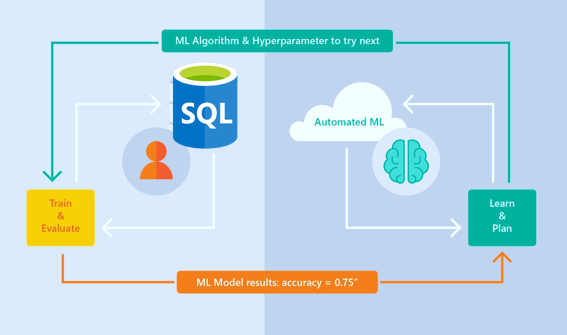AI-powered applications are trending. With the best user experience case, the right data sets are accessed with larger models. Machine learning and AI with Microsoft SQL are designed to bring the best values to critical concepts.
Hire SQL server developers experts from India can provide for secure & excellent SQL service and configure development tools. It enables the smooth functioning of languages like Java, Python, and R. It is ideal for predictive learning and setting practical examples for business organizations. The same can be done with open-source packages and frameworks. There is no need to shift the data from SQL. Machine learning models are also deployed in this manner.
The rise of machine learning and AI in SQL
Businesses all around the globe are undergoing a transformation as a result of Microsoft SQL and artificial intelligence. As the rate of change quickens, the rate at which value is added must also quicken faster. In order to assist you in scaling data science, attaining rewards, and securing a career advancement. To make the most of the many career prospects available in this sector, you need to acquire a practical and functional knowledge of SQL, artificial intelligence and machine learning tools and methods. Acquire the knowledge and abilities of the modern day in order to effectively collect ongoing insights, handle frequent difficulties, and make choices that are better informed. Utilizing Generative AI to accumulate value and unlock the next frontier of development is a great way to maximize earnings and return on investment.
Also, Due to the recent release of ChatGPT and the subsequent conversations around the potential dangers of improperly using the AI tool, you may have been exposed to a great deal of information regarding artificial intelligence. On the other hand, even if you are not currently using ChatGPT, we are willing to risk that you have interacted with artificial intelligence at least once during the last five minutes. This is due to the fact that artificial intelligence has grown so prevalent that the instances of it that we come across on a daily basis seem to be endless.
The prospects for the use of machine learning or artificial intelligence in Microsoft SQL
Artificial intelligence has been expanding at a quick rate over the last several years and will continue to have a significant amount of influence in the world of business and economics well into the coming decades.AI is seen to be bringing an effect on a variety of legal, financial, and corporate problems, such as its effects on human labour, industrial frameworks ranging from infrastructure to administration, effects on the range of working time, thereby reducing time range and that impact working space, and the connection between robots utilized to work and their method of impacting productivity at work.
The question of whether artificial intelligence (AI) is already having an impact on human labour participation in the fields of business, healthcare, and legal sections, as well as in the educational sector and industries, is now being discussed. It would seem that the structural composition of machines and robots that are powered by artificial intelligence is able to do jobs more effectively and more quickly than human labour, particularly in the areas of time-related activities and heavy responsibilities.
Extraction of Features and Selection of SQL

The high dimensional and unpredictability that are present in the raw data are reduced via the process of feature extraction, which also finds variables that represent the most critical and distinguishable aspects of the input signal. As a general rule, the process of feature engineering begins with the generation of initial features from the raw data and continues with the selection of a small subset of the features that are the most appropriate. However, feature engineering is a process that is iterative, and other approaches, such as feature transformation and dimensional reduction, may also play a part in the implementation of this process.
There are a variety of methods available to produce features from raw data, and these methods vary depending on the kind of data:
In order to extract low-variance characteristics from signal and picture data, wavelet scattering makes use of specified wavelet and scaling filters. Learning strategies that do not need supervision, such as reconstruction ICA and sparse filtering, are able to acquire effective models by revealing the separate parts and optimizing for scarcity in the feature distribution.
Integrating Azure Synapse And SQL Server For Hybrid Analytics
Organizations invest significantly in on-premises data infrastructure like SQL Server, which powers business applications that interact with cloud capabilities.
The process of selecting features involves determining a subset of characteristics that continue to have predictive value, although with a reduced number of features and a more compact model. A number of different approaches to autonomous feature selection are accessible, such as rating features according to the predictive potential they possess and learning the relevance of features in conjunction with the parameters of the model. Other techniques of feature selection include the iterative determination of a collection of characteristics that maximize the performance of the particular model.
When SQL Was First Created
SQL initially came in as a result of the requirement to communicate databases in a manner which were standardized. Prior towards the start of SQL, every database management system (DBMS) had the individual process for constructing queries, which made the process difficult for designers. Through the provision of a language that is organized, user-friendly, and standardized, SQL revolutionized the unwilling by allowing users to query, alter, and define data. The simplicity of SQL is one of its greatest strengths; it enables the expression of complicated queries, creating use of syntax which are both streamlined and easy to understand.
Currently Existing Dangers for SQL Designers
When have you executed a query using SQL? When did the simple code transform unprocessed data into data that had a purpose?
Numerous people able to unlock the complex world of databases by using SQL, which was the strategic method which opened the door. Many of them have relied on SQL ever since the beginning in 1971. It have been the foundation for all of these groups. However, just like every other technology, SQL needs to develop. Previously, professional SQL developers were able to function independently, but they now need to examine how artificial intelligence (AI) may make their skills more robust.
Application software is more networked than it has ever been before. Multiple and diverse sources, including the cloud, can quickly recover databases, and there is an ever-increasing requirement for speeds, suppleness, and safety in relation to these databases. Injections of SQL, for example, to remain to be a significant threat to the security of data. Additionally, enhancing queries to manage enormous amounts of data is a difficulty which never goes away.
AI and ML: The rising core of evolution
(AI) is no longer a reality that is firmly embedded in almost every field of technology. Artificial intelligence has the ability to automate repetitive processes in software development, including signifying fixes, enhancing coding, and forecasting problems before they arise. Artificial intelligence works alongside humans and allows them to write code which is both more efficient and safe.
The Continuous Development of SQL: Why Artificial Intelligence and ML Is Necessary for SQL
- It is necessary for SQL to undergo another round of adaptation in light of the explosion in IT and the proliferation of data. In the case of SQL, accepting AI implies automating a great deal of work. AI has the potential to significantly improve a number of processes, including code alteration, schema development, and type inference.
- AI does not replace SQL; instead, it assists developers in the creation of queries that are both more efficient and safe. An example of this would be a tool driven by artificial intelligence. Tasks like schema creation, type implication, and code rectification are now improved thanks to the use of artificial intelligence.
- If you receive a notification from an associate anytime, a query has the potential to be insecure or incompetent or automatically recommend improvements.
- This is the aspect of AI that adds value to SQL. It is a benefit for software publishers to realize this. Tools enabled by artificial intelligence make it efficient. Nonetheless, it even makes it more accessible. As a result, developers are free to concentrate on the development process, leaving the optimization and correction to artificial intelligence.
Interaction between artificial intelligence and Microsoft SQL
An exciting area of study is the interaction between artificial intelligence and database management. It is incorporated into numerous parts of database administration as artificial intelligence (AI) continues to further its development. Artificial intelligence has the potential to revolutionize the process of building, maintaining, and optimizing databases.
In database management systems, the indexing of data, the optimization of queries, and the tweaking of performance may all be automated via the use of advanced artificial intelligence algorithms and machine learning methods. This not only enhances the effectiveness of databases but also enhances the whole experience that users have when interacting with them.
In addition, artificial intelligence may assist in the recognition of patterns and trends inside enormous datasets, which enables businesses to make well-informed choices and get valuable insights. The combination of artificial intelligence with database management has the potential to provide new opportunities and to foster the growth of a variety of industries throughout the world.
Understanding the Advantages of Using AI and ML-Driven SQL for Database Management

- One of the most significant benefits of using AI to drive SQL is the capability to automate processes that are of a repetitive nature. Database administrators have been needed to compose and execute SQL queries for a considerable amount of time in order to accomplish activities such as retrieving data, manipulating data, or doing data analysis. The procedure is lengthy, wastes a lot of time, and is prone to mistakes caused by humans.
- Nevertheless, the processes are automated via the use of AI-driven SQL, which not only saves time but also reduces the likelihood of making errors. Artificial intelligence algorithms are able to scan vast volumes of data and generate SQL queries in order to fulfil these jobs in an automated manner. This enables database managers to focus on more strategic work.
- SQL is driven by artificial intelligence, which has the capability of improving database performance, which is another benefit. Databases often get overloaded by enormous amounts of data, which leads to a decrease in overall performance as well as a delayed response time to queries on the database.
- SQL powered by artificial intelligence may analyze the database to identify places in which performance might be improved. It is able to generate SQL queries automatically, which optimizes the structure of the database, its indexes, and its execution plans. This results in faster response times to queries and improved overall performance.
- Database administration is undergoing a transformation thanks to AI-driven SQL solutions, which are opening up new frontiers.
Bottom Line
As more ML development solutions company begin to use the power of artificial intelligence in their operations, the need for competent SQL developers is expected to expand rapidly. Utilizing machine learning and AI with Microsoft SQL in response to the growing demand from businesses for experts can improve their data management procedures, there has been an increase in the number of job openings or vacancies for SQL developers.
Read More:
- Achieve Cloud Scale On-Prem: SQL Server 2023 CU10 Capabilities
Microsoft made sizable engineering investments ensuring the newest SQL Server release brings the the best of the cloud on-premises.





